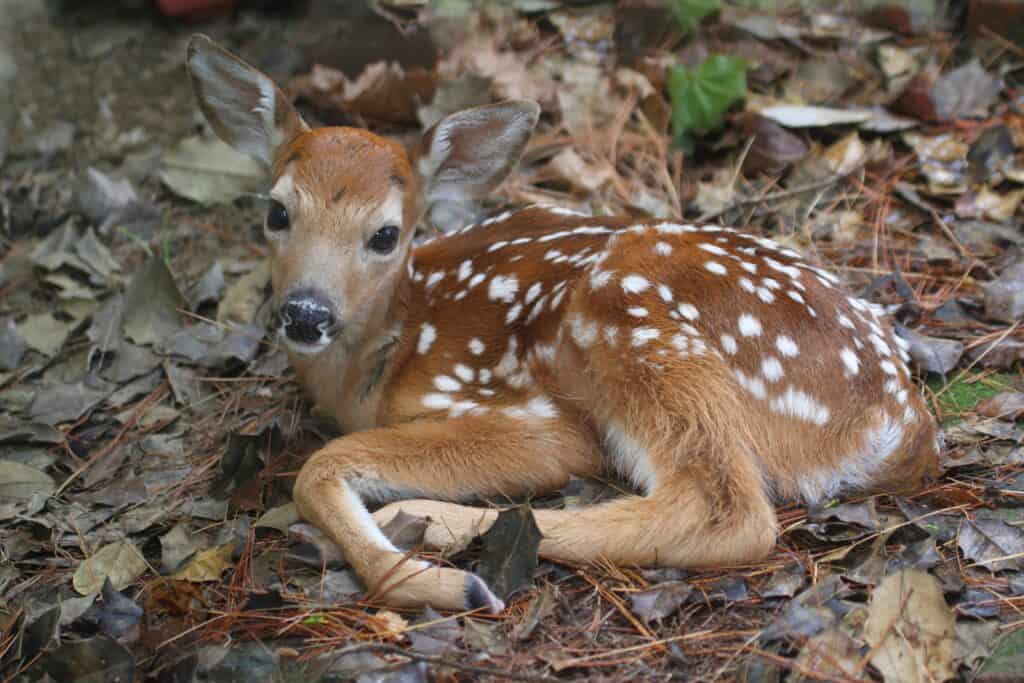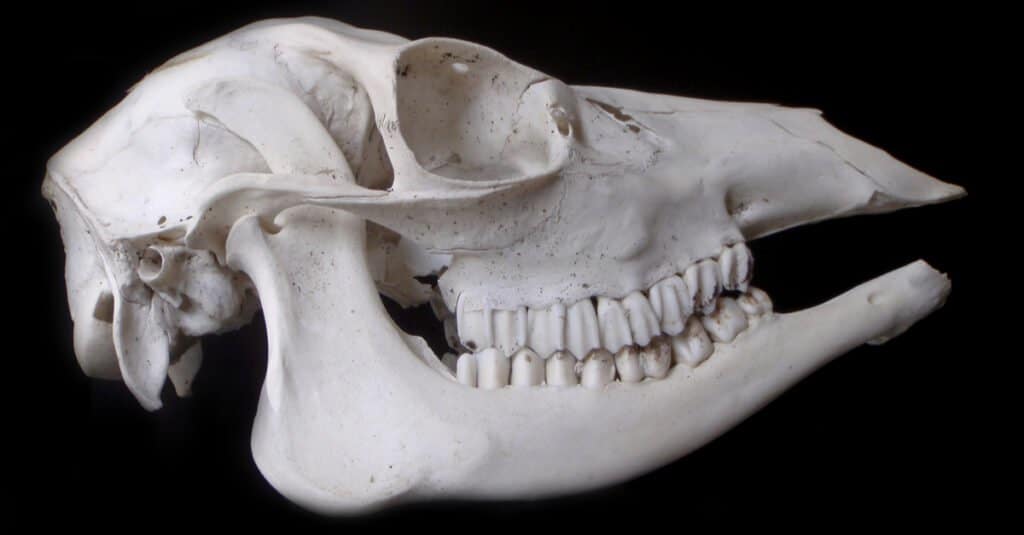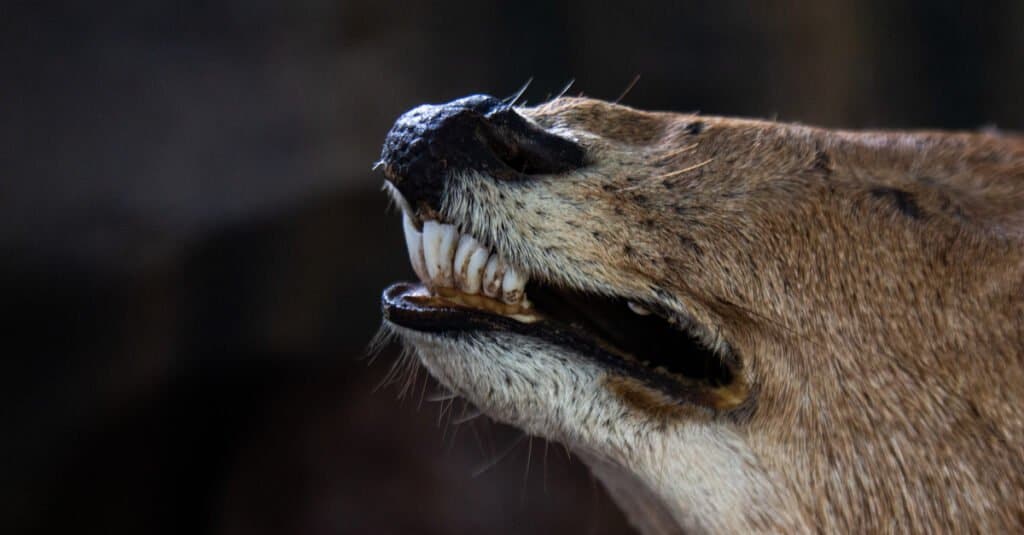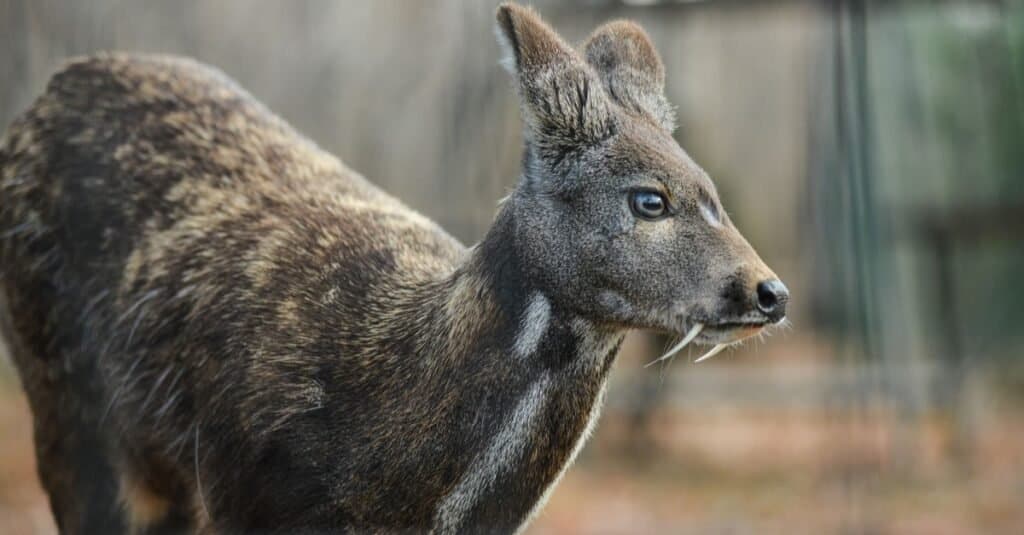Deer have been a part of human culture for tens of thousands of years; they’re still hunted today for their meat, skins, and trophy antlers. These members of the Cervidae family live across the Americas, Europe, and Asia, and are largely characterized by the seasonal growing and shedding of antlers. They include white-tail deer, mule deer, moose, elk, key deer, roe deer, reindeer, Chinese water deer, and fallow deer–among others. Almost all species of deer have the same type and number of teeth, but a few stand out for their unique tusks.
Here, we’ll take a deep dive into the specific characteristics of deer dentition, starting with deer baby teeth. Then, we’ll take a closer look at each type of tooth the deer has, what they look like, and how they function. Next, we’ll learn more about where deer do–and don’t–have teeth, and just how to tell a deer’s age from looking at its teeth. Then, we’ll explore the strange teeth of the Chinese water deer–the famous pint-sized vampire deer.

Fawns rely on their mother’s milk for the first few weeks of life.
©Steve Byland/Shutterstock.com
Baby Deer Teeth: Milk Teeth
Fawns rely entirely on their mother’s milk for the first few weeks of life. Their teeth start to come in almost immediately, and by the time they’re six months old, their adult teeth begin to replace their deciduous (baby) teeth.
Incisors
Fawns have eight incisors, all in their lower jaw. These teeth are small and much more delicate than the adult teeth will eventually be.
Premolars
Unlike adult deer, fawns don’t have any molars, only premolars. The premolars are small, and have three cusps (pointed ridges used for chewing), while the adult premolars have two cusps. Fawns tend to eat a diet of more tender food than adult deer do, and have more gracile teeth to match. They retain these baby premolars until they’re about 18 months old.
How Many Teeth Do Deer Have?

Most species of deer have 32 teeth, but some have 34 teeth
©Chris Moody/Shutterstock.com
Deer don’t have all of their adult teeth until they’re about 2.5 years old. By this time they’ve lost all of their baby teeth–they’re replaced by an adult, permanent teeth. They also gain their molars. Adult deer have 32 total teeth; six incisors, two canines, 12 premolars, and 12 molars.
Incisors
All species of deer have a complement of eight teeth at the very front of their bottom jaw. Six of these are widely considered incisors, while the corner teeth (those closest to the premolars) are sometimes called canines. Functionally, they’re the same. The incisors’ purpose is for grabbing onto and pulling off food, like leaves, stems, and branches. Without the incisors, deer would have no way of getting food into their mouths.
Some species of deer actually have 34 teeth; they have two additional upper canines that aren’t present in other species. These teeth don’t do much functionally, and their exact purpose is unknown.

Mule deer eating weeds in a flowery summer garden.
©Ginger Livingston Sanders/Shutterstock.com
Premolars
The next teeth after the incisors are the premolars; all deer have 12 premolars. There is a large, toothless gap in the jaw between the incisors and the premolars called a diastema. The premolars are smaller than the molars but have the same irregular, ridged occlusal (chewing) surfaces.
Molars
The molars are the most robust teeth in the deer’s mouth. They’re located directly behind the premolars, and like the premolars, there are 12 of them. The molars exhibit the same ridged surfaces as the premolars. These ridges run long ways along the teeth–that is, from snout to tail, rather than from cheek to tongue. When the deer chews, these ridges rub across each other, creating a perfect chewing surface for the tough vegetation of the deer diet.
Do Deer Have Upper Front Teeth?

©Dany Kurniawan/Shutterstock.com
Like many herbivores, deer do not have upper front teeth. Instead, they have a fleshy plate called a dental pad. This dental pad functions as one big cutting surface (think of a cutting board, with the lower incisors acting as the knives). This is where the primary job of cutting up the food before it heads down to the molars for further mastication happens.
Aging Deer with Their Teeth
Because deer go through two sets of teeth in their life, and because their adult teeth wear as they age, it’s possible to accurately determine the deer’s age using their teeth.
First, deer don’t get their final molar until they’re about two years old. So if they only have five cheek teeth, or if the sixth cheek tooth is only partially erupted, they’re two years old or less.
Once a deer has all of its teeth (around 2.5 years), the key to aging shifts to analyzing the amount of wear on the teeth. Young deer have high, sharp crowns on their teeth, especially the cheek teeth, which continue to erupt for much of the deer’s life. The older the deer, the smoother their teeth look. Further, as they wear down, more of the dark brown dentin material beneath the enamel becomes visible.
Fanged Deer

Some deer have fangs that make them look like “vampires.”
©Suvorov_Alex/Shutterstock.com
Several species of deer, including the Chinese water deer, muntjac, and tufted deer, have replaced their antlers for something decidedly stranger; fanglike canine teeth.
In these species, the upper canines are not only present–but huge. Male Chinese water deer have such large ‘fangs’ that they’ve often been compared to vampires. Like male deer of other species do with their antlers, they use their tusks to compete with other males over mating rights and social dominance.
When they’re not using their fangs to fight, deer like the Chinese water deer actually pull their fangs backward, keeping them out of the way for eating. This is possible because the fangs are loosely socketed, and the deer have special muscles just for manipulating them. It’s a good thing too–they can get up to three inches long in males, and would certainly hamper feeding if they were immobile.
The photo featured at the top of this post is © Dany Kurniawan/Shutterstock.com
Thank you for reading! Have some feedback for us? Contact the AZ Animals editorial team.






